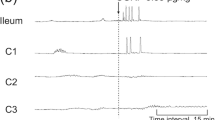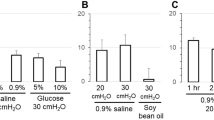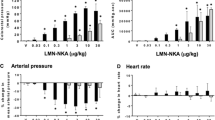Summary
In pentobarbital-anaesthetized rats (60 mg/kg, i.p.) renal pelvis distension with a pressure of 80 cm H2O caused a decline in mean arterial blood pressure. This pressure response, which disappeared rapidly after cessation of the distension, was used to study the effects of analgesic drugs known to be effective in renal colic pain in man.
Morphine (0.75 and 1 mg/kg, s.c.) and the decapeptide caerulein (1.6, 4 and 8 μg/kg, s.c.) abolished the pressure response. The effects of the largest doses lasted for at least 30 min. Ineffective in this respect were (a) desulphated caerulein (40 μg/kg, s.c.) and (b) additional doses of pentobarbital (20 and 40 mg/kg, s.c.). This shows (a) the importance of the sulphated tyrosine (known from previous studies on central effects) and (b) the missing influence of the depth of anaesthesia.
Naloxone (0.5 mg/kg, s.c.) abolished the effect of morphine (1 mg/kg, s.c.) but failed to influence that of caerulein (8 μg/kg, s.c.). Even a fourfold dose of naloxone (2 mg/kg, s.c.) did not weaken the effect of caerulein. Naloxone, per se, was ineffective. These results suggest different mechanisms of the present effects of morphine and caerulein.
It appears that renal pelvis distension in the anaesthetized rat can serve as a model of renal colic.
Similar content being viewed by others
References
Basso N, Bagarani M, Gizzonio D, Basoli A, Fiocca F, De Paolis C, Praga C, Speranza V (1981a) Analgesic effect of ceruletide (CRL) in biliary and renal colic. Gastroenterology 80:1105
Basso N, Bagarani M, Gizzonio D, Fiocca F, De Paolis C, Praga C (1981b) Analgesic effect of ceruletide (CRL) in biliary and renal colic. Pain (in press)
Doi T, Jurna I (1981) Intrathecal substance P depresses the tail-flick response — Antagonism by naloxone. Naunyn-Schmiedeberg's Arch Pharmacol 317:135–139
Doi T, Jurna I (1982) Analgesic effect of intrathecal morphine demonstrated in ascending nociceptive activity in the rat spinal cord and ineffectiveness of caerulein and cholecystokinin octapeptide. Brain Res 234:399–407
Downman CBB, McSwiney BA (1946) Reflexes elicited by visceral stimulation in acute spinal animal. J Physiol (Lond) 105:80–94
Ferrari M, Oggioni E, Rossi AC (1981) Some further pharmacological data on ceruletide. Int Symp Brain-Gut Axis, Florence, June 29–July 1, Abstracts: 60
Geigy JR (1968) Documenta Geigy, Wissenschaftliche Tabellen, 7. Auflage, Basel
Gubergritz MM, Istschenko IN (1926) Zur Frage der Entstehung der Schmerzempfindungen in den Nieren. Z Ges Exp Med 52:619–633
Hill RG (1981) The status of naloxone in the identification of pain control mechanisms operated by endogenous opioids. Neurosci Lett 21:217–222
Jacob JJC, Ramabadran K (1977) Opioid antagonists, endogenous ligands and nociception. Eur J Pharmacol 46:393–394
Jurna I (1980) Effect of stimulation in the periaqueductal grey matter on activity in ascending axons of the rat spinal cord: Selective inhibition of activity evoked by afferent Aδ and C fibre stimulation and failure of naloxone to reduce inhibition. Brain Res 196:33–42
Jurna I, Zetler G (1980) Analgesia following central administration of caerulein and cholecystokinin octapeptide (CCK-8). Naunyn-Schmiedeberg's Arch Pharmacol 313: Suppl R 26
Jurna I, Zetler G (1981) Antinociceptive effect of centrally administered caerulein and cholecystokinin octapeptide (CCK-8). Eur J Pharmacol 73:323–331
Lawrence D, Livingston A (1981) Opiate-like analgesic activity in general anaesthetics. Br J Pharmacol 73:435–442
Le Bars D, Chitour D, Kraus E, Dickenson AH, Besson JM (1981) Effect of naloxone upon diffuse noxious inhibitory controls (DNIC) in the rat. Brain Res 204:387–402
Leek BF (1972) Abdominal visceral receptors. In: Neil E (ed) Handbook of sensory physiology, vol III/1 Enteroceptors. Springer, Berlin Heidelberg New York, pp 113–160
Løyning Y, Oshima T, Yokota T (1964) Site of action of thiamylal sodium on the monosynaptic spinal reflex pathway in cats. J Neurophysiol 27:408–428
Piazza E, Brambilla M, Cattaneo MT, Martini A, Pacciarini MA (1981) Analgesic activity of ceruletide in cancer patients. Int Symp Brain-Gut Axis, Florence, June 29–July 1, Abstracts: 146
Procacci P, Zoppi M, Maresca M (1979) Experimental pain in man. Pain 6:123–140
Risholm L (1954) Studies on renal colic and its treatment by posterior splanchnic block. Acta Chir Scand 184:Suppl 1–64
Risholm L, Ulfendahl HR, Öbrink KJ (1959/1960) Pressure and peristalsis in the upper urinary tract of the dog in experimental ureteric occlusion. Acta Chir Scand 118:304–311
Rutishauser G, Graber P (1962) Beobachtungen bei akuter Ureterstauung im klinischen Modellversuch. Z Urol 55:537–542
Sachs L (1978) Angewandte Statistik, statistische Methoden und ihre Anwendungen, 5. Auflage. Springer, Berlin Heidelberg New York
Sawynok J, Pinsky C, Labella FS (1979) On the specificity of naloxone as an opiate antagonist. Life Sci 25:1621–1631
Skofitsch G, Lembeck F (1980) Visceral pain mediated by capsaicin sensitive neurons. Naunyn-Schmiedeberg's Arch Pharmacol 313: Suppl. R 32
Sweet WH (1959) Pain. In: Handbook of Physiology: Section 1: Neurophysiology. American Physiological Society, Washington DC, pp 459–506
Weakly JN (1969) Effect of barbiturates on “quantal” synaptic transmission in spinal motoneurones. J Physiol (Lond) 204:63–77
Whitteridge D (1956) The effects of distension of viscera. In: Lectures of the Scientific Basis of Medicine, Vol 4. University of London, The Athlone Press, pp 305–310
Yaksh TL, Yeung JC, Rudy TA (1976) An inability to antagonise with naloxone the elevated thresholds resulting from electrical stimulation of the mesencephalic central gray. Life Sci 18:1193–1198
Zetler G (1980a) Caerulein and cholecystokinin octapeptide produce analgesia and ptosis in mice. Naunyn-Schmiedeberg's Arch Pharmacol 311: Suppl R 66
Zetler G (1980b) Analgesia and ptosis caused by caerulein and cholecystokinin octapeptide (CCK-8). Neuropharmacology 19:415–422
Zetler G (1980c) Effects of cholecystokinin-like peptides on rearing activity and hexobarbital-induced sleep. Eur J Pharmacol 66:137–139
Zetler G (1981) Central effects of ceruletide analogues. Peptides 2 Suppl. 2 (in press)
Zetler G (1982a) Cholecystokinin octapeptide, caerulein, and caerulein analogues: Effects on thermoregulation in the mouse. Neuropharmacology (in press)
Zetler G (1982b) Caerulein and morphine: An attempt to differentiate their antinociceptive effects. Pharmacology (in press)
Author information
Authors and Affiliations
Rights and permissions
About this article
Cite this article
Brasch, H., Zetler, G. Caerulein and morphine in a model of visceral pain. Naunyn-Schmiedeberg's Arch. Pharmacol. 319, 161–167 (1982). https://doi.org/10.1007/BF00503931
Received:
Accepted:
Issue Date:
DOI: https://doi.org/10.1007/BF00503931




